By Jeffrey A. Rendall, Photos By Jeff Janas
FAYETTEVILLE, PA -- It's strange how two siblings can come from the same family, yet appear and act so differently.
Likewise, it's somewhat odd how two golf courses can co-exist at the same locale, yet look and play very distinctly. That's the case for Penn National Golf Club's Iron Forge Course (built in 1995), much younger family member to the club's Founders Course, which opened in 1968.
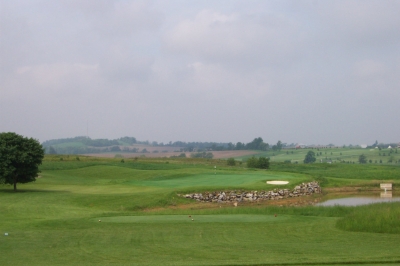 |
| The 183 yard, par three 6th hole is the Iron Forge Course's signature hole. |
Both are owned by the same group, have a similar architectural pedigree, and share the land's common history. Yet the Iron Forge course would rate closer to the Founders' polar opposite than its identical twin.
According to Iron Forge's designer, Bill Love, that's exactly the way they wanted it: "Just taking a look at the property where we built the Iron Forge Course, it was obviously quite a bit different than the older course -- simply because there weren't very many trees (and the Founders Course has thousands)."
Love and the Penn National folks used the lack of trees to their advantage: "It was intended to be a very naturalistic type golf course. The idea was to blend it into the terrain in a way that it appears as though it's always been there, and is very compatible with the existing topography. We sought to use the property's natural rolling qualities, and where possible, let the land dictate the contours. That was our goal, and I think we accomplished it pretty well," said Love.
"We designed Iron Forge to incorporate large un-maintained areas -- conservation space, if you will. So, in the sense that we cut down on the amount of mowed turf areas, and then used native grasses and indigenous plant material to fill in the borders -- it gives the course a look as though it was meant to be there. It also drastically cuts down on the amount of water that the facility requires, so it's very environmentally friendly, too," added Love.
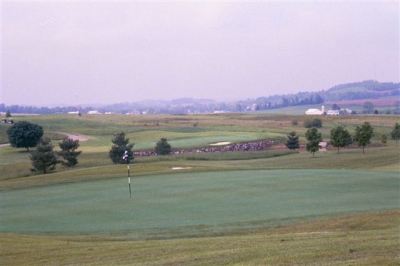 |
| From the 5th green, you'll see quite a bit of Iron Forge's landscape. |
Love's acquired a reputation for environmentally conscious golf designs, having dreamed up Hunting Hawk (near Richmond, VA) and Lee's Hill (near Fredericksburg, VA) -- both of which are known for welcoming the birds, bees and weeds (wetlands to the layperson).
But just because there're large native areas doesn't mean the course will cause you to struggle, with longing looks at yawning stretches of tall vegetation surrounded by 'Environmentally Sensitive Area, Keep Out' signs. Such areas may keep the wild and plant life happy, but they're also known as wayward golf ball storage facilities.
Bill Klimkiewicz (hereafter known as Bill K), Penn National's General Manager, says the opposite is true -- Iron Forge is extremely player friendly. "The Iron Forge Course plays a lot different than the Founders. It's a wider lane of golf, with fairway landing areas being 40+ yards wide, versus about 33 yards on the Founders Course. And like the Founders Course, there are very few forced carries. If you combine wider avenues with a lack of forced carries and the generous amount of roll you'll get from the bentgrass fairways, you'll find the Iron Forge course is very popular with higher handicappers."
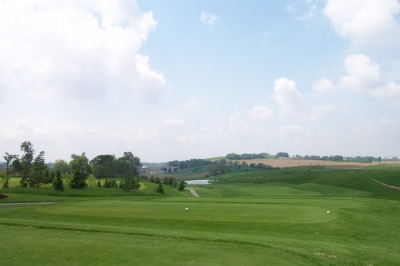 |
| Bill Love gives you lots of room to drive the ball, but you'd still better choose your spots carefully. Here, the view from the 15th tee. |
It's also popular with better players challenging the back tees. Bill K. explains why: "The greatest resistance to scoring on Iron Forge is the work on and around the greens. If you can keep the ball in play, you'll have a chance to shoot low, but a lot of people aren't ready for the test they'll get on the putting surfaces. We run them at 10 on the stimpmeter, and they also have more undulations than on Founders. On some holes, if you don't look at your putt from at least two angles, you'll read the break wrong."
"Putts on holes 4-10 tend to break away from the mountain, away from the Appalachian Trial. Some players come off that course and swear their putts were breaking uphill, which is physically impossible -- but because of the way the greens were notched in and the moguls were shaped, it creates a little deception there," Bill K said.
That's not even mentioning the 'natural' elements on the Iron Forge Course. You'll play the Founders Course in a fairly level valley, with trees protecting shots from the ravages of the airstream. Not so on the newer layout.
Love says the breeze factored into his thinking on designing wide playing areas: "What we didn't want to do was create a tight golf course on the side where the wind's blowing all the time, and then just get in the situation where it becomes too aggravating for the average player. With the course being fairly open, the choice becomes how much you want to bring the natural areas into play when the wind's blowing. There are also some realistic operations considerations behind this, like pace of play, and also the fact that they're going to want people to enjoy their rounds of golf when they come there."
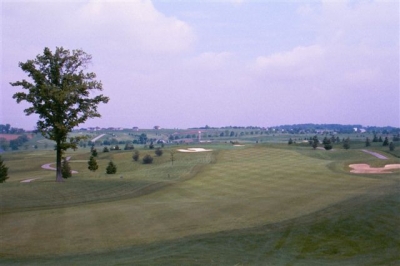 |
| Come back down the hill off the tee of the 405 yard, par four 9th hole. |
And even though there's plenty of space to hit the ball, and the wind's blowing, and there aren't many trees... don't call Iron Forge a links-style course. "It's not intended to be a links-style course," said Love. "I think that phrase is terribly misused by people. As soon as you've got an open course with a limited number of trees, people are saying it's a links course. That's much too simple a definition."
Besides, true links courses often have some very penal bunkering, or knee high grass where you wouldn't necessarily expect it or see it. That would violate Love's philosophy for golf: "I believe golf is supposed to be fun. That doesn't mean hit it a little off line and you're in your bag again. Part of the excitement of the game is, when you hit a bad shot, having the opportunity to recover without an extreme penalty."
But then again, if you anger the Gods of the game, punishment is forthcoming: "We're big believers in risk-reward situations, where you'll have a chance to make a good score, but you'll have to hit a precise shot. Take the sixth hole for example (187 yard par three). The water's right up against the green, with plenty of bailout room to the left -- and if you want to get close to the pin, you'll bring the water into play. If you're content with trying to get up and down for par, then aim away from the water," Love mused.
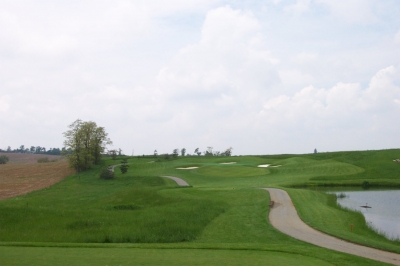 |
| The par three 16th hole plays 198 yards, all uphill. |
He continues, "For the most part, we'll give golfers a little bit of room and build it into the design strategy. You'll have to decide which side of the hole you're going to play to reach the pin placement at the right length. That accommodates not only the better player who's trying to score seriously, but also the average player, who can hit it a bit right or left and still have some fun without taking 'x' on a number of holes."
In addition to the enjoyment you'll get from playing golf on Iron Forge, you'll also learn some history lessons. Bill K's been at Penn National for years, and he appreciates the land's significance: "We got the name 'Iron Forge' from the fact that iron ore trains used to run through the east side of the property, and there's even an old lime kiln up behind the ninth tee there. They actually had horse-drawn wagon trains coming up the slope there and dumping the limestone to be cooked in these kilns."
There's more: "Iron Forge sits at the base of the Michaux Forest and the South Mountains there. And on top of that ridge, just to the east is the Appalachian Trail," Bill K lectured.
So Iron Forge has steely solid connections to history as well -- fitting for this part of the country.
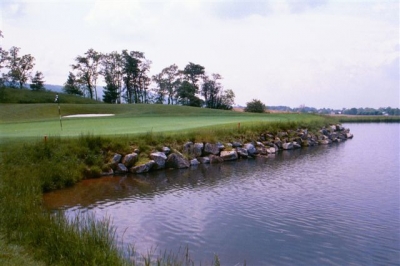 |
| Don't go right on the 15th hole, or you'll be reaching for the ball retriever. |
Hole highlights include number four, named 'The Natural,' because very little dirt was moved to create the hole (419 yard par four). Bill K said essentially all that was done was to put some mounding on the sides, and some large bunkers on the left side of the tee ball landing area. The green has a large false front, and presents a pretty narrow target -- with bunkers on the right and a shaved chipping area to the left.
The sixth hole (as mentioned above, a 187 yard par three over water) is probably Iron Forge's signature hole. It's slightly downhill with water guarding front and right. There's only one small pot bunker on the hole, and the number of pin positions on the large green can make a couple clubs difference on your tee box decision-making. And, as Love mentioned above, there's quite a lot of room to the left to chicken out (I mean bail out).
On the inward nine, the 11th hole is another great example of Iron Forge's risk-reward qualities (539 yard par five). Bill K does the description honors: "If you hit a big drive, you'll have a chance to try for the green in two -- but you've really got to hit a perfect shot to get there. If you pull it, you're in the water, and if you push it, you could bounce over into the really high rough. You can still make birdie there if you lay-up to your favorite yardage spot on your second shot. It's an excellent, strategic hole."
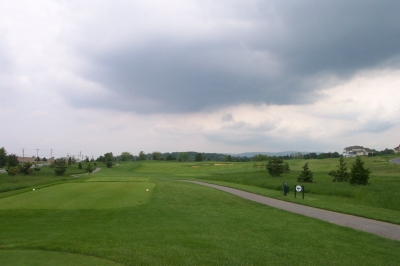 |
| One final decision awaits on the 18th tee. Challenging the bunkers to leave it on the right side will certainly shorten your 2nd shot. |
Fifteen was another favorite. It's a downhill, dogleg left par four. There's quite a view from the tee, with a red barn in the background and an old 17th century cemetery up on the hill (according to Bill K). There's a pond right of the green, mandating another accurate iron shot.
The round concludes with another risk assessment, at the 409 yard par four eighteenth hole. It's a dogleg right with what appears to be a split fairway. Large bunkers guard the right side, which if chosen provides a much shorter second shot. The larger left side will leave a longer approach into a tiered green.
Bill K says they get a fair amount of visitors from the Baltimore/Washington area, and a popular way to play at Penn National is to try both courses in one day. "We have a very attractive day/play rate, which essentially allows people to play both courses for less than a hundred bucks, even during peak season. You can leave your house at 5:30 in the morning, tee off at 7:30 or so, finish up in the late afternoon and head home. It's a great deal."
It is indeed. Two upscale courses, nice facilities, beautiful surroundings -- and nice variety in settings and challenges. As siblings tend to do, the Iron Forge Course will 'mature' and become more like its older brother, the Founders Course. Bill K says they'll gradually introduce some low flowering deciduous trees, and there are already about 600 pine trees on the course. In 30 years, it'll look quite a bit different -- it'll become a little less 'open,' and a little more tree-lined.
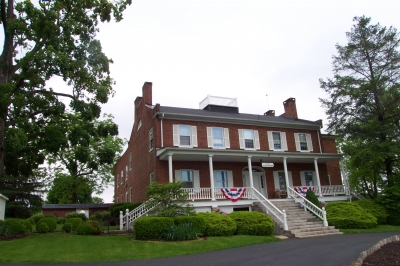 |
That's okay, it'll still be part of the same 'family' experience.
Where To Stay: Accommodations available at nearby Chambersburg, though we recommend staying right on property at the Penn National Inn (there are also stay and play golf packages available).
The Inn is located adjacent to the 8th fairway on the Founders Course, and offers 52 guest rooms with two full-size beds, cable TV, refrigerators and coffee makers in every room. The rooms are a good deal larger than a 'standard' motel room, providing more than enough space to do your morning stretches prior to hitting the links.
You'll check in at the Pre-Civil War White Rock Manor House, which also has four guest rooms (and according to the clerk, some have suggested that 'spirits' reside there, too).
Details:
Penn National Golf Club's Iron Forge Course
3720 Clubhouse Drive
Fayetteville, PA 17222
Phone: (717) 352-3000
Toll Free: (800) 221-7366
Website: www.penngolf.com
Course Designer: Bill Love
General Manager: Bill Klimkiewicz
Head Golf Professional: Dave Beegle
Penn National's President: Dennis Zimmerman
| Tees | Yardage/Slope | Rating |
| Black | 7009/133 | 73.8 |
| Blue | 6602/130 | 71.9 |
| White | 6300/128 | 70.4 |
| Green | 6001/125 | 69.0 |
| Red | 5246/120 | 70.3 |
Rates:
In-season, from mid-April to mid-October, $55 for 18 holes with a cart, Mon-Thurs, $68, Fri-Sun. Senior discounts available Mon-Thurs, and twilight rates starting at 2:30 p.m., and super twilight at 3:45 p.m.
| Related Links | Comments on this article? | |
|
Maryland National Golf Club Hollow Creek Golf Club Rocky Gap Resort PB Dye Golf Club in Ijamsville Whiskey Creek Golf Club |
E-mail Jeff Rendall, Editor: jrendall@golftheunitedstates.com |











